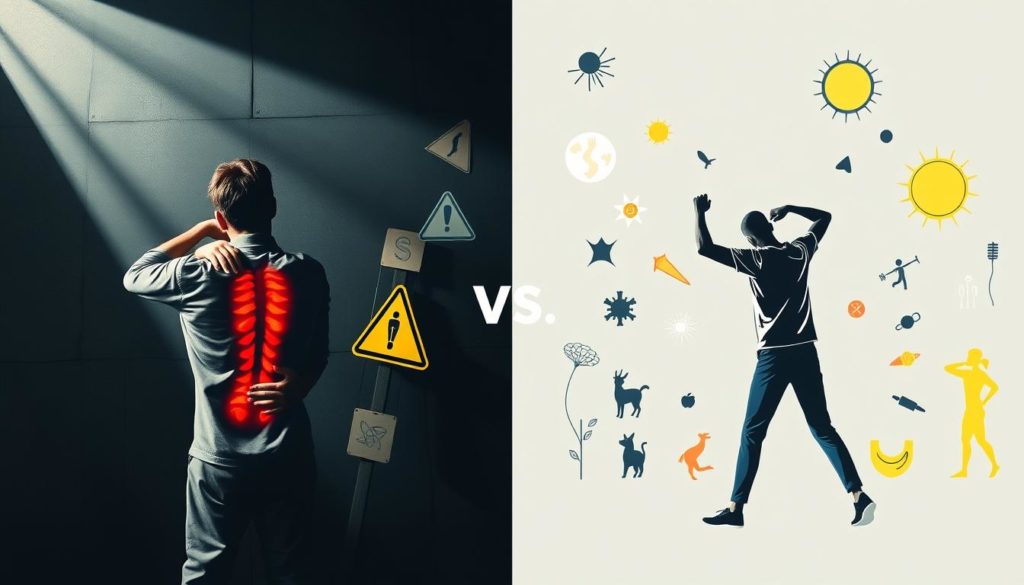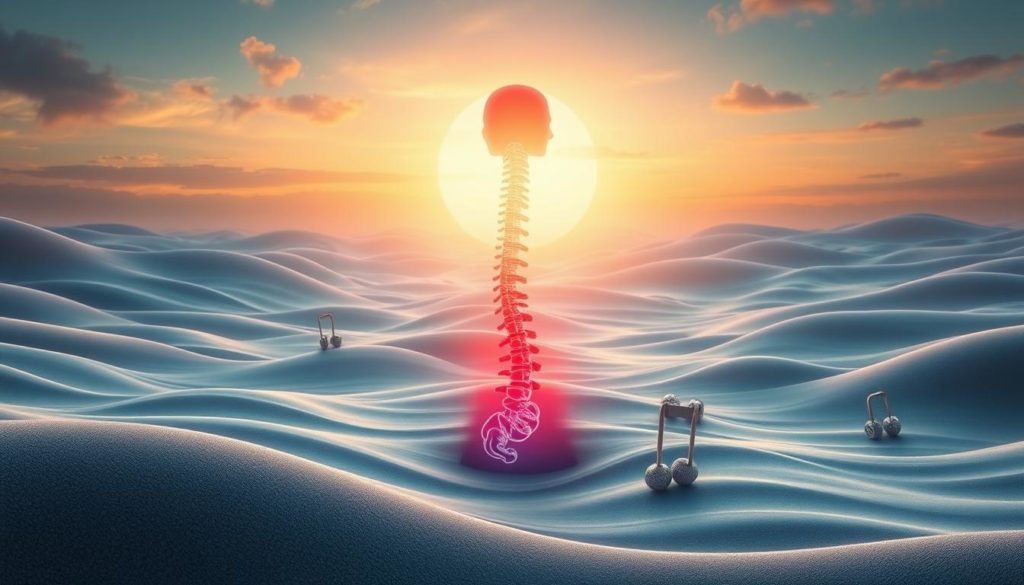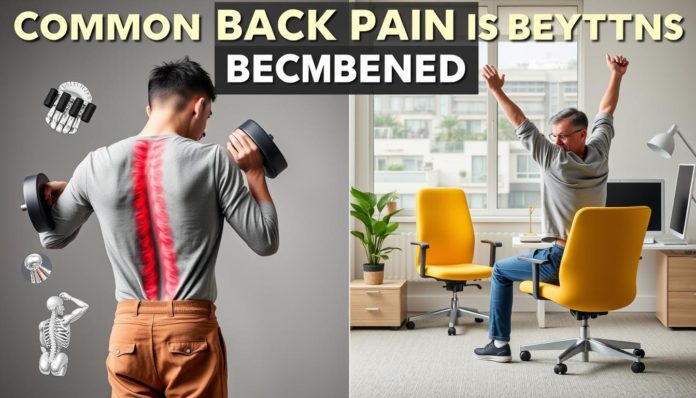Did you know that nearly 80% of adults will face back pain at some stage? However, myths about back pain often worsen the situation. It’s important to clear up these false beliefs and shed light on the truth.
Many people wrongly believe myths about what causes back pain and how to treat it. Justin Kertis, a physical therapist, says our spine is strong and made to move. He explains that not all back pain means serious damage or needs surgery.
It’s also not true that a weak core or bad posture alone cause back pain. Nor does it come from just “wear and tear.” Moving and strengthening exercises help manage and ease back pain. Stress, sleep, and lifestyle play a part in making our backs more prone to pain.
Back Pain is Always Dangerous
Many think if your back hurts, it’s always a big problem. But, that’s a common back pain myth. Most of the time, back pain is not linked to serious health issues. It can often be treated well.

The Reality of Acute Injuries
The University of Maryland Medical Center says a lot of back pain comes from minor injuries. These can be things like pulling a muscle or spraining something. Even though it hurts, you can usually take care of it at home. Rest, cold packs, and common pain relievers usually help you get better.
This shows us a back pain myth vs reality situation. Not every ache needs a doctor’s visit.
Managing Chronic Back Pain
Long-term back pain doesn’t always mean you are still hurting your back. Nor does it mean you need an operation. Things like stress, not living healthily, or sitting too much can make your back hurt over time. Summit Orthopedics says keeping your back strong and living healthily can lessen long-term pain.
This is different from the false beliefs about back pain that say chronic pain is always a sign of big trouble. Knowing the real facts about back pain can help you take care of it better. It also makes it less scary.
Persistent Back Pain Indicates Serious Damage
Many think that if your back hurts for a long time, it means something is seriously wrong. But, that’s not always true. Injuries usually heal within three months. So, chronic pain might be caused by something else. Summit Orthopedics says many believe in this myth about back pain. They explain the reality is quite different.
Things like stress and how well you sleep can impact your pain. Knowing this is important for treatment. Stress can make the pain worse, and bad sleep can stop you from getting better. It’s key to know the truth about these myths to manage back pain well.

One big myth is that constant pain means constant harm. It’s critical to understand that you can feel pain even after the injury has healed. Looking at both the mind and body helps treat back pain better. This approach helps patients get better results.
To sum up, we shouldn’t just think about the physical side of pain. Your mental health and lifestyle changes are important too. They can lead to a real recovery. This shows how wrong those back pain myths can be. And it can lead to a happier life.
Scans Always Show the Cause of Back Pain
Many believe that MRIs and X-rays perfectly diagnose back pain causes. This myth often causes confusion about one’s condition and treatment options. Scans can show things like disc bulges or wear and tear. Yet, these don’t always match how much pain you feel or how it limits your activities.
The Misleading Nature of Imaging
Images can sometimes lead to wrong conclusions. A person might think their scan shows the exact cause of their pain. However, studies have found that not everyone with these scan findings feels pain. This shows that a clean scan doesn’t mean your back is perfect, and signs of problems don’t always mean pain.
Alternative Diagnostic Approaches
Since scans have their limits, other ways to find out what’s wrong are key. Checking how you move and live, along with physical exams, gives a fuller picture of your back pain. Doctors can then make plans that really suit you, proving scans aren’t the only way to tell what’s wrong. Understanding this offers a complete view on managing back pain, moving beyond the myths.
Back Pain is Caused by Poor Posture
Many people wrongly think false beliefs about back pain come from bad posture. But, studies show that our spines can adapt well to different postures. The real issue is not moving enough and staying in one position for too long.
When we look closely at these back pain myths busted, it’s clear that trying to stay in one “perfect” posture isn’t key. Instead, sitting comfortably and changing your position often helps avoid pain build-up.
- Variation is Key: Changing your posture periodically is more beneficial than sticking to one rigid position.
- Comfort Over Correctness: Finding a position that feels most comfortable to you can be more effective in managing back pain.
- Movement Matters: Regular movement and avoiding static positions can alleviate back pain more effectively.
To clear up some common false beliefs about back pain from posture, let’s compare myths and facts:
| Myth | Reality |
|---|---|
| Poor Posture Causes Back Pain | A variety of postures can be sustained without causing pain when movement is incorporated. |
| Perfect Posture Prevents Pain | Changing positions frequently is more effective for pain prevention. |
By debunking these back pain myths busted, we learn that managing back health is about common-sense strategies.
Common Back Pain Myths
It’s vital to understand the truth about back pain to treat it correctly. There are many myths that cause needless worry, wrong treatments, and long-lasting discomfort. We’re going to bust some of these common back pain myths and show how they affect the way we treat back pain.
An Overview of Misconceptions
The spine is much tougher than most people think. The myth that any back pain means something serious is wrong. In fact, most back pain comes from everyday issues and isn’t a sign of lasting trouble. Another myth is that you must stay in bed if your back hurts. While resting can help, too much rest might actually make it worse.
The Impact of These Myths on Treatment
Believing these myths about back pain can change how people seek help. Thinking you need to avoid moving can slow down recovery. It’s usually better to keep moving gently to stay flexible and strong. Also, knowing that bad pain doesn’t always mean big damage can help people feel less scared when dealing with back pain.
Here’s a quick look at some myths and the truth:
| Misconception | Truth | Impact on Treatment |
|---|---|---|
| Any back pain means severe damage | Most back pain is mechanical and temporary | Leads to unnecessary fear and anxiety |
| Complete bed rest is necessary | Prolonged inactivity can worsen the condition | Encourages prolonged discomfort and stiffness |
| The spine is fragile | The spine is resilient and strong | Discourages appropriate physical activity |
A Weak Core Causes Back Pain
A lot of people think a weak core causes back pain. It’s true a strong core helps keep the body stable and supports certain actions. But, it’s not the only thing that affects back pain.
Some experts have found that back pain can make the core muscles tight. This is to protect the spine. It doesn’t mean your core is weak. It’s just how our body tries to stay safe.
It’s not just about making the core stronger. Learning to use and relax these muscles well can help handle back pain better.
Knowing the true causes of back pain leads to better treatment options. It helps avoid the misleading myths about back pain.
Back Pain is Caused by Wear and Tear
Many people think daily wear and tear causes back pain. This isn’t true. Normal activities do stress the back, but they don’t doom it to damage. In fact, certain exercises and movements actually make the back stronger and more flexible. This information helps clear up common misunderstandings about back pain.
Strengthening the Back Through Use
Lifting, pushing, and pulling help make back muscles stronger, not weaker. These actions prove everyday activities aren’t bad for the back. By including these exercises in your routine, you keep your back strong. This helps prevent back pain from getting worse over time.
The Role of Exercise and Movement
Exercise and movement are key for back health. Adding activities like swimming, yoga, and Pilates to your life can make your back more stable and less painful. Being active is not only a way to avoid back pain. It also helps treat back pain for those who already have it. This is important for understanding back pain myths and why being inactive isn’t the answer.
Here is a look at some common myths and what’s actually true:
| Myth | Reality |
|---|---|
| Exercises wear down the back | Exercises strengthen the back |
| Avoid physical activity to prevent pain | Regular activity prevents and treats pain |
| Daily wear and tear is harmful | Daily wear and tear is manageable |
It’s vital to correct these myths about back pain. Staying informed and taking action can greatly improve your back health. This makes a big difference in your life overall.
Flare-ups Mean Ongoing Damage
Many believe that back pain flare-ups signal ongoing damage. This common myth about back pain needs clearing up. In truth, stress, mood changes, and non-routine activities can cause flare-ups. It’s vital to know the difference between myth and reality for good back pain management.
Having a flare-up doesn’t mean things are getting worse. It’s key to separate pain from actual damage. Here’s what to remember:
- Stress: Emotional stress can turn into physical back pain, but it doesn’t mean more harm.
- Mood: Changes in mood can make back pain feel worse because of how our nerves react to pain.
- Unusual Activities: Doing something out of the ordinary can cause a flare-up. Yet, it doesn’t mean damage.
It’s time to debunk common myths about back pain and look at the facts.
| Myth | Reality |
|---|---|
| All flare-ups mean more damage. | Flare-ups often stem from things like stress or doing rare activities. |
| Flaring up requires immediate medical intervention. | Sometimes, you can manage flare-ups with simple changes in activity or how you handle stress. |
Understanding the truth about back pain myths vs reality is essential. It helps keep a good outlook and manage pain well, without extra worry.
Medical Interventions are the Solution
It’s often thought that injections and prescription drugs are the best fixes for back pain. This is a part of the many common back pain myths. These methods usually give just short-term relief and don’t solve the root problems of pain.
The Temporary Relief Provided by Injections and Drugs
Medications and injections can work well for managing pain quickly. They can lessen pain and inflammation for a while. But, they’re not made for lasting relief. Relying too much on these without trying physical therapy and exercise can keep back pain myths alive.
When Surgery is and isn’t Necessary
Many see surgery as the ultimate fix for back pain, but that’s not always true. Especially for those suffering long-term pain, surgery should be a last choice. Professionals stress that surgery might not get to the bottom of the issue. Instead, lifestyle changes, physical therapy, and behavioral adjustments can provide a deeper solution for managing pain over time.
To sum up, choosing medical steps alone without looking into other tested treatments can restrict effective back pain care. A whole approach that combines different therapies offers better outcomes and can make life better.
Bed Rest is Best for Back Pain
Many think the best way to ease back pain is by resting in bed. Yet, researchers now say that staying inactive might make things worse. This myth of resting to heal back pain has been proven wrong more often than not.
Staying in bed for too long can cause muscles to get stiff and weak. This weakening can make it harder to get back to daily activities. Soon, what seemed like a solution turns into a bigger issue, causing more pain and longer recovery.
Doctors say it’s better to keep moving gently to speed up getting better. Low-impact activities like stretching and walking strengthen muscles and ease pain. Moving helps get more blood flow to the sore spots, helping them heal faster.
So, it’s clear that being active, not staying still, helps with healing back pain. Letting go of this myth about bed rest is key to dealing with back issues better. It’s important to follow medical advice for a quicker and healthier recovery.
FAQ
Is back pain always a dangerous sign?
No, it’s not always serious. Acute injuries like strains usually don’t need big treatments. Chronic back pain often comes from stress or how we live, not just injury.
Does persistent back pain mean that I have serious damage?
Not really. Most injuries get better in three months. Chronic pain may come from stress or bad sleep, not just damage.
Do scans like MRIs or X-rays always show the cause of back pain?
No, they don’t always tell us why we hurt. They show aging changes not always linked to pain. We should also check our lifestyle and how we move.
Is back pain usually caused by poor posture?
Not exactly. Our spines handle many postures well. Moving often helps more than staying still. It’s good to sit comfortably and change positions often.
Are there common myths about back pain that affect treatment?
Yes, myths about needing to rest a lot or staying in one position can mislead us. They can make us too scared to move, which might not help.
Does a weak core directly cause back pain?
Not straight away. A strong core helps, but pain can make the core tight. It’s good to know how to use core muscles well for back health.
Is back pain caused mainly by wear and tear?
No, the spine gets stronger with normal activities like lifting. Exercise is key to preventing and managing back pain, not the cause of it.
Do flare-ups mean ongoing damage to my back?
Flare-ups don’t always mean more damage. They can start from stress or doing new things. Knowing this helps us handle them better.
Are medical interventions like injections or surgery the best solutions for back pain?
Injections and drugs help for a while but don’t fix the root problem. Surgery is for certain cases. Changing how we live and act often works better.
Is bed rest the best approach for managing back pain?
No, staying in bed too much can make things worse by making muscles weak. Doing safe activities helps with healing, supports muscles, and keeps us flexible.


